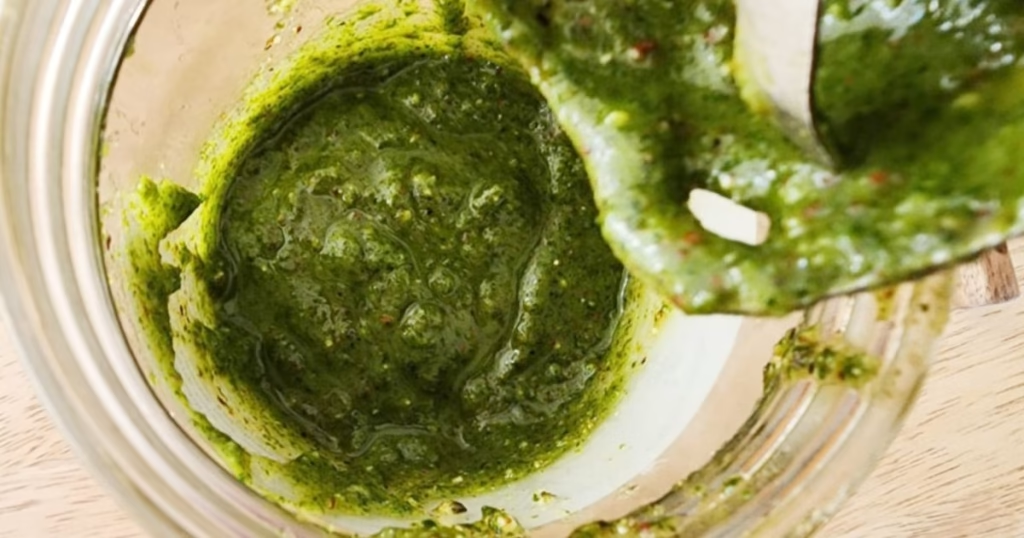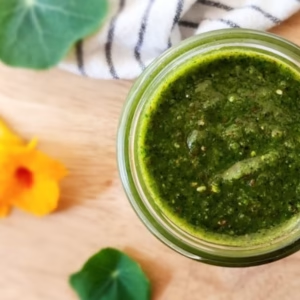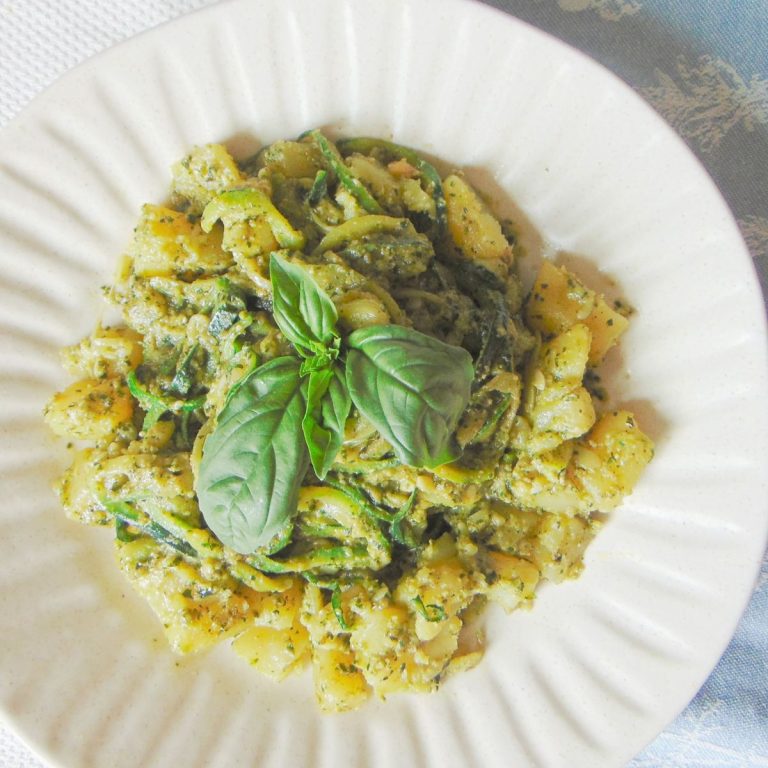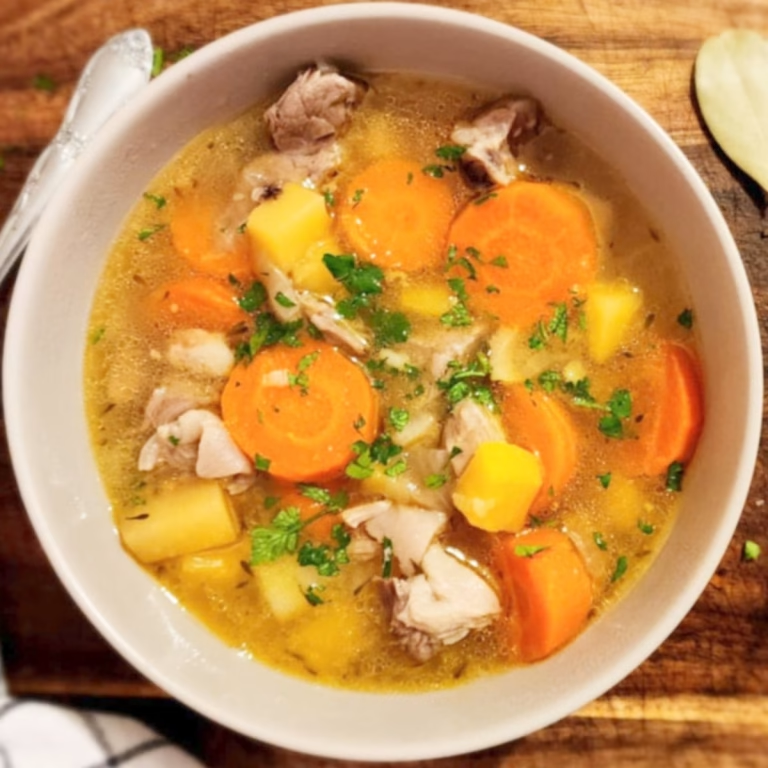If you have some nasturtium growing in your garden and are wondering how to use it, this nasturtium pesto is the perfect recipe to try. It’s a bold, peppery twist on a classic. Creamy, fresh, and bursting with flavor, this pesto is ready in just 10 minutes. Spread it on toasted bread, toss it with pasta or zucchini noodles, serve it as a dip for veggies or meatballs, or just enjoy it by the spoonful. It’s that good!

Disclosure: as an Amazon Associate, I earn a small commission from qualifying purchases at no extra cost to you. Read my full Disclosure and Policy here.
This year, I tucked some nasturtium seeds into a small empty corner of my raised beds, not thinking too much of it at the time. Only later did I discover what a powerhouse plant nasturtium really is for the garden. It attracts pollinators and beneficial insects, repels squash bugs and other pests, and even works as a natural trap crop for aphids. To my surprise (and relief!), the squash I planted nearby were the only ones to make it through the season untouched by all those pesky squash bugs.
Now that summer is winding down, my nasturtium has grown into a lush, vibrant plant that deserves to be enjoyed beyond the garden bed. And what better way than turning it into pesto? This nasturtium pesto is bold, peppery, and bursting with freshness, the perfect way to capture a little taste of summer in a jar.
What Is Nasturtium?
Nasturtium (Tropaeolum majus) is an annual flowering plant originally from South America, now grown widely as both an ornamental and culinary herb in temperate climates. It thrives in many conditions and is wonderfully easy to grow. Its name comes from the Latin nasus tortus, meaning “twisted nose,” a perfect description of the peppery, nose-tingling bite of its leaves and flowers.
Beyond the kitchen, nasturtium is a fantastic garden plant. It attracts beneficial insects, repels pests, and makes an excellent companion plant for squashes and cucumbers by helping keep squash bugs and cucumber beetles away. Its vibrant flowers and round, lily-pad–like leaves add cheerful pops of color to any backyard.

Culinarily, nasturtium is often underestimated. The leaves, flowers, and even seeds are edible, with a distinctive peppery flavor perfect for salads, pestos, and garnishes, as well as soups and stews. The leaves taste a bit like mustard greens or arugula, while the flowers are milder, with a delicate floral note. Many consider them the best-tasting edible flowers!
Even the unopened flower buds are delicious. Often called “poor man’s capers”, they can be pickled or fermented to make a flavorful and affordable alternative to traditional capers. Find a lacto-fermented nasturtium capers recipe here!

Why You’ll Love This Recipe
As a gardener, I love finding ways to use everything I grow whenever I can. Carrot tops turn into the most wonderful soups (find my carrot tops soup with ginger and bone broth here), and all the garlic scapes and onion greens are put to good use. Nasturtium leaves and flowers certainly don’t go to waste: they brighten up salads and find their way into all sorts of recipes! Read this post if you want to start your own vegetable garden on a budget.
This nasturtium pesto is one of the easiest and most delicious ways to enjoy nasturtium fresh from the garden. It’s bold, bright, and just a little spicy. A fun twist on the classic pesto you already love. And the best part? It comes together in minutes.
You’ll love how versatile it is too: spread it on bread, toss with pasta, drizzle over roasted veggies, or serve alongside grilled meats and fish. Try swapping it for salsa verde in my Instant Pot beef tongue recipe, or pair it with zucchini noodles for a light, refreshing side dish.

This nasturtium pesto is also a wonderful way to preserve that vibrant garden flavor and color as summer winds down. Freeze it in portions, and you’ll have something ready to brighten meals all year long.
Ingredients for This Nasturtium Pesto

Nasturtium leaves and flowers. Freshly picked at any time of the season! Use a mix of leaves and flowers for a balanced taste. Early in the season, when the plants are young, using only leaves works perfectly too.
Basil (optional). For an extra sweet and aromatic touch, add a little basil. It pairs beautifully with the bolder, spicier nasturtium. If you don’t have any, sticking with just nasturtium is wonderful as well.
Olive oil. Adds creaminess and flavor to the pesto, helping all the ingredients blend together.
Almonds. Their mild, slightly sweet flavor balances the peppery nasturtium nicely. You can also use cashews, macadamia nuts, or pine nuts for a gentle taste, or walnuts and pecans for a stronger, more robust flavor.
Parmesan cheese (optional). Brings richness and depth, making the pesto extra creamy. Feel free to skip it for a dairy-free version.
Garlic. A classic in every pesto. Fresh garlic gives the best flavor.
Salt. A little goes a long way to bring out the flavors. I love using Redmond Real Salt for its unique mineral-rich taste.
Tools You May Need
Food processor or immersion blender
How To Make Nasturtium Pesto
Step 1. Gather and prepare your ingredients. Remove any stems from the nasturtium and basil, then wash and dry the leaves and flowers if needed and dry them well. Peel the garlic and grate the Parmesan.
Step 2. In a food processor or large jar, combine 3 cups nasturtium leaves, ½ cup basil (if using), 2–3 garlic cloves, ½ cup almonds, ½ teaspoon salt, and ½ cup olive oil. If all the nasturtium doesn’t fit at once, add it in batches as you blend.

Step 3. Blend until smooth. If needed, drizzle in a little extra olive oil until the pesto reaches a creamy consistency.

Step 4. Add ½ cup Parmesan cheese (if using) and pulse briefly to mix. Taste and adjust the seasoning if needed.

Storage
Transfer the pesto to a clean, airtight jar or container. Store in the refrigerator for 5–7 days, topping with a thin layer of olive oil to keep it fresh. For longer storage, freeze in ice cube trays or small jars, then transfer to a freezer bag. It will keep for up to 9 months.
If you tried this nasturtium pesto recipe, I’d love to hear from you! Drop me a comment down below and let me know how you enjoyed this pesto. Don’t forget to leave me a 5-star review if you loved this recipe!
Pin It For Later

More Recipes You May Like
Quick and Easy Marinara Sauce (Keto-Friendly)
Zucchini Noodles with Chicken, Tomatoes and Parmesan Cheese
Zucchini Noodles with Pesto and Potatoes Recipe
Spaghetti Squash Carbonara Recipe (Grain-free, Keto)
Fermented Carrots and Ginger Two-Way Recipe
How to Make Lacto-Fermented Onions
Fermented Coleslaw: Easy and Delicious Gut-Healthy Recipe
Carrot Tops Soup with Bone Broth and Ginger
Easy Instant Pot Beef Tongue with Italian Salsa Verde
Printable Recipe Card

Nasturtium Pesto: A Bold, Garden-Fresh Recipe
Equipment
- food processor or immersion blender
Ingredients
- 3 cups packed nasturtium leaves and flowers
- ½ to ¾ cup extra virgin olive oil
- ½ cup almonds or other nuts
- ½ cup parmesan cheese shredded, optional
- ½ cup basil leaves optional
- 2-3 cloves garlic
- ½ tsp salt
Instructions
- Gather and prepare all your ingredients. Remove any stems from the nasturtium and basil, then wash and dry the leaves and flowers if needed. Peel the garlic and grate the Parmesan cheese.
- In a food processor or large jar, combine 3 cups of nasturtium leaves, ½ cup of basil (if using), 2–3 cloves of garlic, ½ cup of almonds, ½ teaspoon of salt, and ½ cup of olive oil. If all the nasturtium leaves don’t fit at once, start with half, then add the rest as you blend.
- Blend until smooth. If needed, drizzle in a little more olive oil and continue blending until the pesto reaches a creamy consistency.
- Add ½ cup of Parmesan cheese and pulse briefly to incorporate. Taste and adjust the salt, if needed.







Can I find nasturtium flowers & leaves at farmers markets? Or do I need to try a hot house? I don’t garden anything myself right now (heads over to your link about starting a veg garden) but this sounds like a yummy topping I’d love to try!
Ehi Claire, I have never seen it at any markets or stores, maybe the best way would be to ask anyone with a garden. Many gardeners plant nasturtium as a bug repellent and not many use it as a culinary herb, so I’m sure they won’t mind sparing some 🙂
I love pesto , and this variation of it was delicious 🤤
Thank you very much, Jasmin!
An awesome recipe to use up those garden edibles!
Thank you so much!
I love this!! Nasturtium is SO underrated! I use mine to make a chimichurri.
Thank you so much, Meredith! That sounds delicious, I want to try that 🙂
This is a wonderful recipe! I’d never heard of nasturtium before but you’ve got me interested in growing some next season.
Thank you so much, Kimberley! Nasturtium is a great plant to grow and super easy too 🙂
I LOVE pesto! Thank you for sharing!
Thank you, Molly! 😉
Love this! I grew nasturtium this year for the first time and I’m excited to try this recipe!
Thank you so much, Megan! I hope you’re gonna like it 🙂
I have nasturtiums in my garden, can’t wait to try this recipe